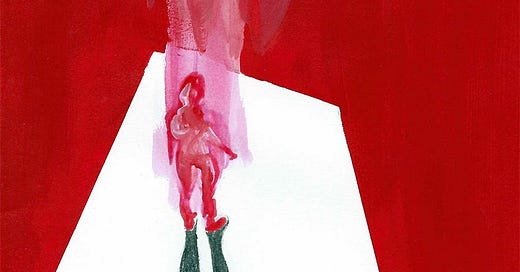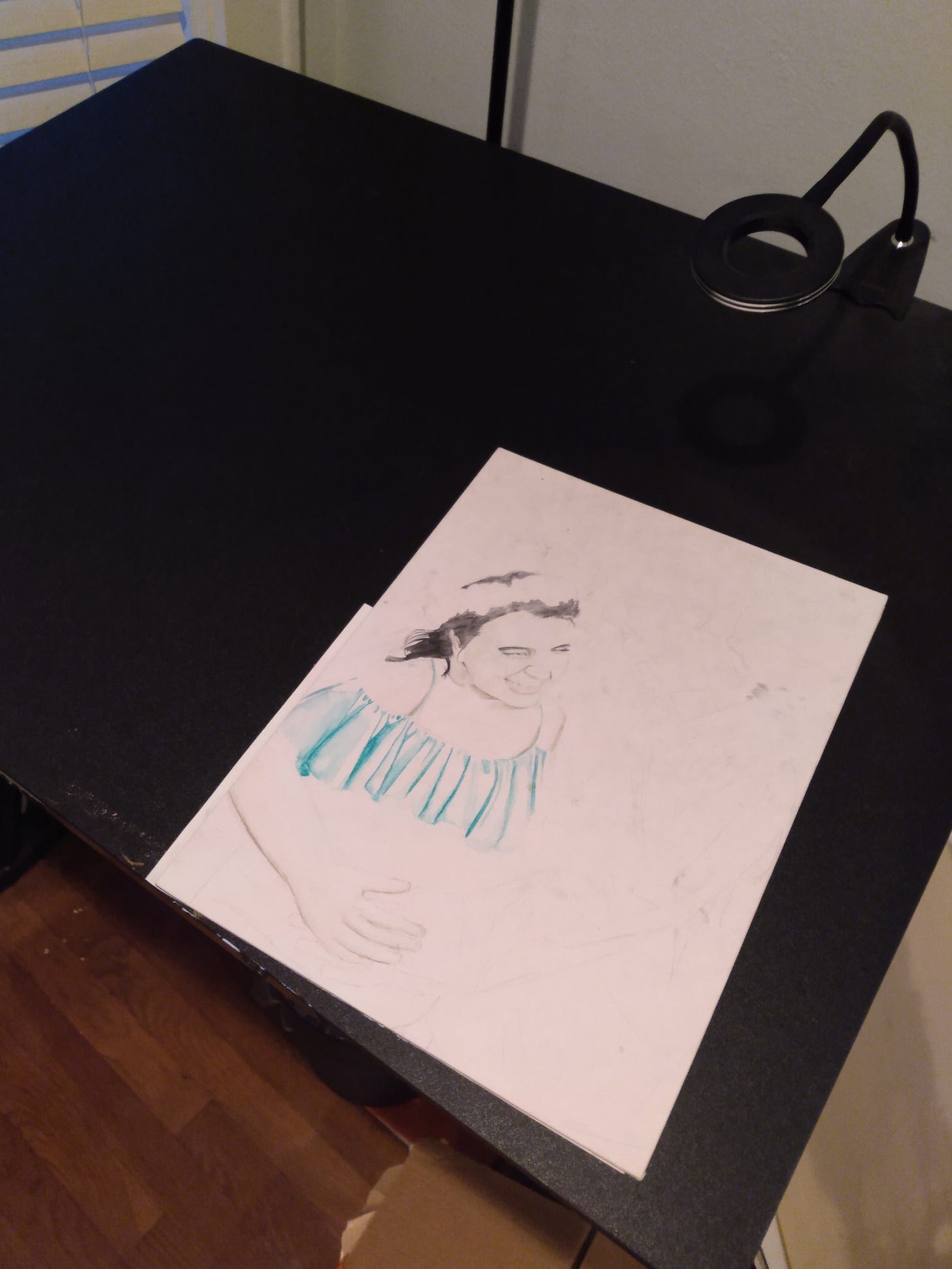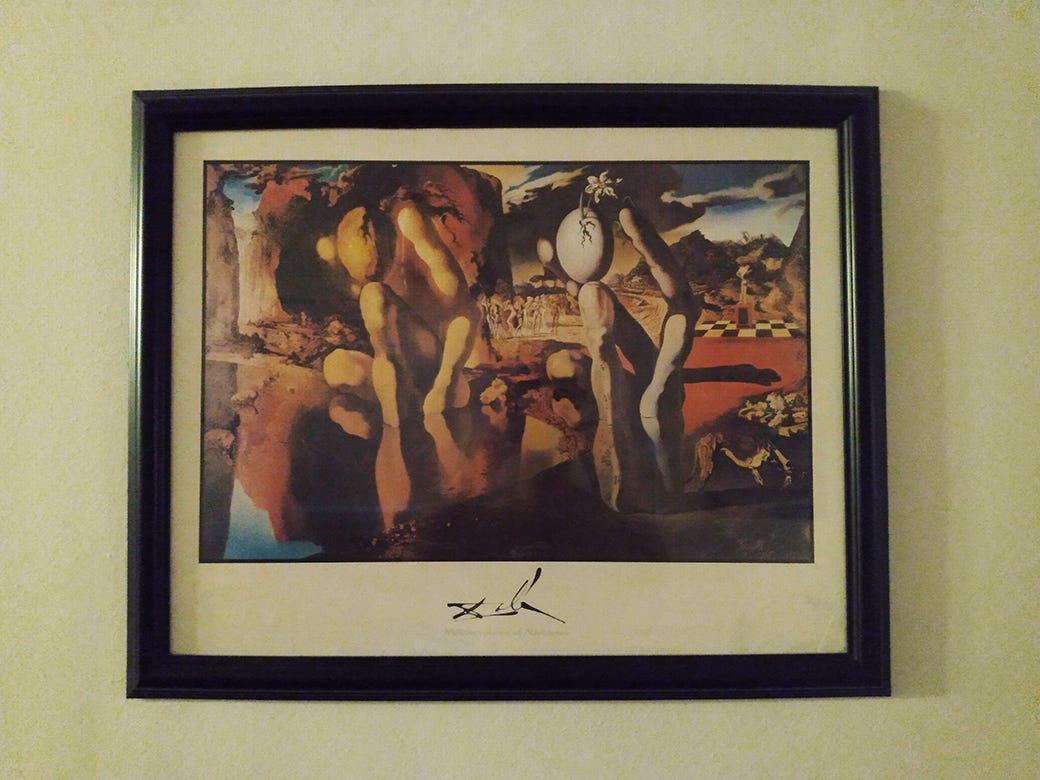The artist realized that the actual work of art was that the unfinished painting of The Only Woman He Ever Loved had been sitting on his drafting table untouched for the last five years. And near that a bookshelf held his favorite fiction books and books about narcissism and psychology and philosophy and physics and on the wall a print of the painting The Metamorphosis of Narcissus by Dalí. The work of art was the combination of those things, the unfinished painting and the books and the print, living dead inside his house. The art was the arrangement in his house. It wasn’t just that. It was him realizing it was that too, that was part of the art, the realization. Sometimes he thought it was like integrating the unconscious, something like that. Unconscious motivations in shadow were illuminated through the light of conscious consideration. And then what. And then what. The “and then what” was the work of art. And then what.
None of those were art. The unfinished painting is literally an unfinished painting, pretending it’s art when the artist realized it had been sitting there untouched for five years and he had made many other paintings but this one painting of The Only Woman He Ever Loved sat unfinished on a drafting table (he had published a poem years prior called Draft, it wasn’t art then but it was right now when he thought about it juxtaposed with an unfinished painting and a bookshelf and a print on the wall) was his reflection in a lake. He could think that and wonder why he liked the Dalí painting, ever since he was a boy and the first time he saw the painting it was one of his favorites of Dalí, he wondered why that one stuck out in particular.
He ruined his romance with The Only Woman He Ever Loved, like he ruined so many things, but there was a feeling that it was one of the only things he had preserved. In college she asked him to sit and eat lunch with her as he was wandering around the dining hall alone and she was beautiful and annoyingly talkative and he wondered why she waved him over. And they had lunch every day and he fell in love with her and she had a boyfriend like they always do and he loved her anyway. And months passed loving her at a distance, without fantasy meeting reality, living inside an unreal world. But eventually that too passed and the fantasy met reality and she became an actual person and he didn’t like that so he ruined it. Broke up with her for reasons unknown. Because she was a person. Reasons unknown. Because that’s just what he does. He’s an artist who ruins things and makes paintings and doesn’t finish some and pretends there’s something beautiful about that, some kind of poetry.
A realization isn’t art and really it’s less than shit, the artist realized over and over. Over and over he realized the banal pain of realizations which became numb, the same way that ripping out his hair didn’t hurt anymore because he had been doing it for such a long time, it was just a habit and it didn’t hurt at all and he realized it was a coping mechanism or a reminder of learned helplessness, a prisoner’s tick, accepting the electric shocks of a floor and just lying there like a dog observed by scientists but he was observing himself and his pain was self-inflicted and everything he did was a way to preserve the primacy of his self and he realized that so it was less than shit and a vehicle for more nothing.
He had a realization about his realizations and the metaphor of unconscious darkness and conscious light: shining a light cast new shadows. And so something previously unconscious became conscious but there were new shadows on the ground and the unfinished painting of The Only Woman He Ever Loved wasn’t art, realizing it had been sitting there untouched for five years haunting his living room wasn’t art, and writing about it right now and his realization that his writing about it was not art was not art.
In the beginning of Ovid’s telling of the myth of Narcissus, Tiresias prophesized to Narcissus’s parents that he would live a long life if he never knows himself. And the artist thought about living a long life and killing himself and all the David Foster Wallace books sitting on his bookshelf next to the print on his wall and his unfinished painting and the fact that Wallace hanged himself and one of the things he said which the artist thought about a lot was, “there’s a lot of narcissism in self-loathing.” And the artist had written something called I’m Not Allowed to Make Art which he hadn’t published because it was unfinished and it was about the art of David Foster Wallace and David Lynch, two of the artist’s favorite artists, and narcissism and love. The artist heard two men talking on a podcast about the two Davids and the voices said Lynch was a better artist than Wallace and the artist agreed with the sentiment and he paused the podcast to write. He wrote about why Lynch was a better artist than Wallace and really he was writing about himself like he always was and his main point was that Lynch loved and Wallace did not. He had watched many interviews with both artists because he loved them both and he observed that Lynch smiled so much and radiated joy and Wallace appeared in almost constant pain, wincing at his own thoughts, his iconic bandana absorbing his sweat, and which, according to his own words, he hoped might prevent his head from exploding. The artist thought about the differences between Wallace and Lynch’s approaches to art, about how Lynch smiled and never explained anything, and he got the impression that Wallace could endlessly explain something, hating every second of it. Wallace had written a nonfiction book, Everything and More: A Compact History of Infinity, and his fiction magnum opus is titled Infinite Jest, and the artist thought about infinity, and the parlor trick infinite hallway one could live (die) inside between two mirrors, and he thought about Narcissus dying staring at his own reflection. The artist thought about Wallace hanging himself, his final act pulling his head away from his body, a separation, an unfinished amputation.
The artist thought about the fact that Wallace admired Lynch’s work and he even wrote an essay about him, and the title of the essay is David Lynch Keeps His Head. The artist thought about dissociation and neuroticism and narcissism and living dead inside a head. He thought about man and the world and machines and media and considering parts of things, of considering man separately from the world, the head separate from the body, machinery being comprised of parts, the body separate from the spirit, man separate from God, reading about characters and arcs, carrying around a digital mirror. The artist planned to end his piece I’m not Allowed to Make Art with a Norm Macdonald anecdote, one of his favorites, another man he loved parasocially through media, the story about how Norm stopped living in perpetual fear inside a head when his father asked him to lead a blind man around town and the blind man asked Norm to describe every single thing he saw, and Norm was forced to stop living inside a head and to look at the world and he couldn’t stop laughing.
(from this YouTube video)
And the artist thought about Echo and The Only Woman He Ever Loved and The Second Story of Echo and Narcissus, the piece by The Last Psychiatrist. He thought about the title of the piece he was writing, An Echo Off the Wall, and how he was planning to end it, but there were things he had to do first. Like consider that when he broke up with The Only Woman He Ever Loved it was because she was a person, not a side character in his story, and that was frightening, and he is a coward. And he broke up with her when she became real, and his painting of her remains unfinished, and he used the verb “haunts” to describe its action, when it sits doing nothing, and the things that haunt are ghosts, echoes of something once living, and he realized he would be haunted forever by that ghost. And he considered ending the piece by finishing the painting, exorcising a ghost, but that’s too obvious, and a conscious realization, so less than shit, and she’s actually one of the only people he talks to, and he cares about her, and even if he finished the painting he wouldn’t share it with the internet, an abstracted world, a psychosis machine, a virtual guillotine, because she is more important than that.
In the beginning of the piece, the artist called the unfinished painting of The Only Woman He Ever Loved his reflection in the lake. It wasn’t Echo, the rejected lover of Narcissus, even though it’s literally an unfinished painting of a lover he rejected, it was his reflection, the thing Narcissus loved, something unattainable. And of course the artist, the narcissist, makes it about himself, she doesn’t even get to be a character, she’s just more of him. And he realized that so the realization turned to stone on the path he walked, a mobius strip of vapid introspection, the random walk of a photon moving back and forth in the sun’s core. He loved it because it was a ghost, because it was unfinished, something with infinite potentials, something without blood, a hypothetical specimen in a jar.
But there were no specimens, the artist realized, and the warped light he saw was the result of the jar through which he observed the world, but the artist thought that if he understood how light reflected and refracted, he could see the world unobstructed. And he took out his interferometer and his calculator, and he made some calculations and he was horrified to discover, he saw the world perfectly. His calculations confirmed that there was nothing to calculate, he could see perfectly well, we were sick. And he realized that, and felt sick, it has to be me that’s sick, he assured himself in isolation, but when he entered the world and interacted with other people and saw the world, his heart couldn’t stop breaking, how sick we are.
And he realized he was more like Wallace than Lynch, in spite of the fact that his own moniker was an homage to the latter, in the same way that the unfinished painting of The Only Woman He Ever Loved wasn’t Echo, it was his reflection, he wasn’t Lynch he was Wallace, even though his name was literally Lynch. And luckily he realized that, he frantically marched in place, an unfinished drawing of the word “eureka” placed between two mirrors, an infinite hallway of nothing, a pathetic trick of light. And he realized too, that writing in the third person perspective when he was writing about himself was a failed attempt at objective distance, as if objectivity were something that were real, as if eyes could float and observe in ether, and as if he could prove wrong the notion that anything written after a particular point in time had to rely on parlor tricks, a subversion of expectation, a breakdown in meaning, accepting a terminal illness, becoming a ghost.
And he realized that he didn’t know Lynch, and he didn’t know Wallace, and he didn’t know much, and they were characters in media, that was literally true, he only ever experienced their presence as ghosts, and recognizing that wasn’t some pathology, it was actually a sign of health and clarity. And he wasn’t a character either, the artist, in spite of being described through words on a screen, all characters were two dimensional, and calling something three dimensional or following an arc was a parlor trick too. Arcs were the trajectories of particles in air, severed heads subjected to air resistance and the force of gravity, mathematics, not art. And the artist wondered if everything Wallace wrote was part of one long suicide note, a trick to summon a ghost, and mathematics was that too. Was that was he was writing?
And the artist realized if that were the case, that all of Wallace’s work was part of a suicide note, that if it was mathematics, an echo of something infinite, but never infinity itself, then the suicide note as art should have as its ultimate aim, words written by a computer, the proper alignment of form and content. And that was the artist’s plan, to write an endless internet novel that was a self-administered Turing Test written by a computer, endless machine optimization and expansion, the logic of logic applied to art, the mundane infinity of words and numbers referencing itself, the ghost in the machine.
So that he could live.
Because the artist realized that An Echo Off the Wall was filled with pictures from inside his own house, and inviting someone into your house was intimate, something for friends, and the artist didn’t have those anymore, and he could feel his head becoming lighter with each keystroke he made, and he wanted to keep his head on his shoulders.
The artist took a picture of The Metamorphosis of Narcissus with his reflection visible but his features obscured. He looked like a ghost. He thought it was a perfect self portrait and he was a genius. He didn’t see the mirror behind him but he planned to write about it.









Amazing